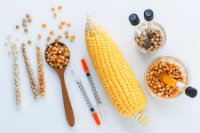5 Natural Ways to Lift Your Libido
/It's hard to admit to yourself. Even harder to talk about. But there it is: your sex drive has taken a dive and you don't know why. You're likely embarrassed, confused and upset. Try not to be. Over the course of a lifetime, it happens to lots of us for lots of reasons.
Studies show that as many as 43% of women and 31% of men experience a drop in libido at some time in their life. Without a doubt, this has an impact on your overall physical and emotional health, as well as your relationship with your partner. Ironically, those same three issues are often the underlying factors in a low sex drive, which can be attributed to lifestyle and relationship problems, age-related hormonal changes, stress, physical disability, and certain medications. But there is help. Before venturing into unknown territory with a mass-marketed "quickie fix," consider a variety of holistic approaches to help lift your libido.
Take Specialized Herbs. Several herbs have been studied for their positive impact on low sex drive, insufficient hormone levels, and performance problems, such as erectile dysfunction or inability to achieve orgasm. Herbs to consider are Panax Ginseng, Yohimbe, Maca Root, and Dong Quai. Each one works differently and some can interact with other medicines. It's important to first consult Dr. Bossio before trying one of these herbal remedies.
Get to the Point with Acupuncture. Shown to be a beneficial complementary therapy for sexual dysfunction, acupuncture can help boost libido by stimulating physiological systems in the body that are involved in sexual response.
Talk about Sex. Sometimes what's not going on in the bedroom has a lot to do with how you and your partner communicate. From the honeymoon period, to being together for decades, sexual needs can and do change. Have honest, open conversations. Consider engaging the services of a sex therapist, who can guide you toward strategies that will lead to more fulfilling and intimate times together.
Enjoy Forbidden Fruits. While there are few specific studies on the aphrodisiac effects of fruits, for centuries different cultures have touted the stimulating benefits of foods such as avocados, figs, pomegranate, dark chocolate, watermelon, and strawberries. The most likely effect of having these foods in your diet is that they provide vitamins and minerals necessary for peak performance of the whole body. Why not experiment with pomegranate wine and dark chocolate nibs to get you in the mood?
Move that Body. Exercise improves circulation, creates sexy muscles, helps manage stress. and promotes both positive body image. When you feel good physically and emotionally, you're more likely to be in the mood for love. Also, working out with your partner can stimulate the sexual energy between you.
Healthy lifestyle practices provide the best foundation for enhancing sexual prowess. When the body is unhealthy, it may not respond optimally to the use of holistic approaches, which are intended to work synergistically with your natural ebb and flow.
Image Atrribution: monkeybusinessimages/bigstockphoto.com
References




















